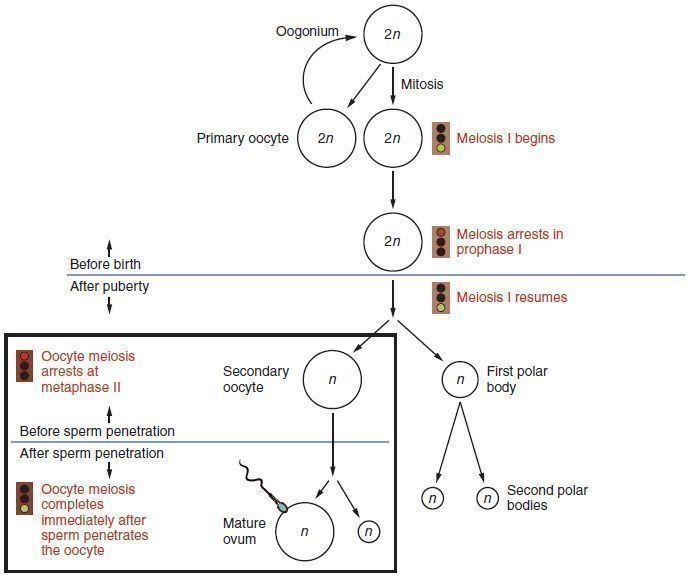
What happens in meiosis during oogenesis?
Answer
408.6k+ views
Hint: Oogenesis is defined as the process of formation of a mature female gamete by reductional division. It is different from the meiosis that occurs in spermatogenesis at one basic feature, i.e., in spermatogenesis all the 4 cells formed get transformed into gametes; but in oogenesis, there is formation of polar bodies.
Complete answer:
The meiosis in case of oogenesis is described as follows:

The oogonial cells undergo the first meiotic division to form the primary oocyte and the first polar body. This is actually a kind of cell division where unequal cytokinesis is observed. One cell gets a larger fraction of the cytoplasm and gets converted into a primary oocyte, and the other one gets converted into a polar body, which later degenerates.
This typical unequal cytokinesis occurs due to the fact that the ovum needs to retain much of the cytoplasm in order to have enough nutrients to nourish the ovum during the early stages of development.
The primary oocyte then undergoes the second meiotic division to release the secondary oocyte and another polar body (2nd polar body). The first polar body also undergoes meiosis-II to release another two small polar bodies.
All the polar bodies eventually degenerate. Thus, from oogenesis, a mature oogonium releases a mature egg or ovum and three polar bodies.
Note:
The point to be noted here is that oogenesis starts itself during birth but gets arrested during the diplotene phase of meiosis-I. Later during puberty, the cycle is again released and continues further. Thus, it is evident that no more oogonium formation occurs after birth.
In human beings from one primary oocyte, a single ovum and two polar bodies are formed. The ovum is released from the ovary in the secondary oocyte stage after the release of the 1st polar body.
Complete answer:
The meiosis in case of oogenesis is described as follows:

The oogonial cells undergo the first meiotic division to form the primary oocyte and the first polar body. This is actually a kind of cell division where unequal cytokinesis is observed. One cell gets a larger fraction of the cytoplasm and gets converted into a primary oocyte, and the other one gets converted into a polar body, which later degenerates.
This typical unequal cytokinesis occurs due to the fact that the ovum needs to retain much of the cytoplasm in order to have enough nutrients to nourish the ovum during the early stages of development.
The primary oocyte then undergoes the second meiotic division to release the secondary oocyte and another polar body (2nd polar body). The first polar body also undergoes meiosis-II to release another two small polar bodies.
All the polar bodies eventually degenerate. Thus, from oogenesis, a mature oogonium releases a mature egg or ovum and three polar bodies.
Note:
The point to be noted here is that oogenesis starts itself during birth but gets arrested during the diplotene phase of meiosis-I. Later during puberty, the cycle is again released and continues further. Thus, it is evident that no more oogonium formation occurs after birth.
In human beings from one primary oocyte, a single ovum and two polar bodies are formed. The ovum is released from the ovary in the secondary oocyte stage after the release of the 1st polar body.
Recently Updated Pages
Master Class 9 General Knowledge: Engaging Questions & Answers for Success

Master Class 9 English: Engaging Questions & Answers for Success

Master Class 9 Science: Engaging Questions & Answers for Success

Master Class 9 Social Science: Engaging Questions & Answers for Success

Master Class 9 Maths: Engaging Questions & Answers for Success

Class 9 Question and Answer - Your Ultimate Solutions Guide

Trending doubts
Give 10 examples of unisexual and bisexual flowers

Draw a labelled sketch of the human eye class 12 physics CBSE

Differentiate between homogeneous and heterogeneous class 12 chemistry CBSE

Differentiate between insitu conservation and exsitu class 12 biology CBSE

What are the major means of transport Explain each class 12 social science CBSE

Draw a diagram of a flower and name the parts class 12 biology ICSE




